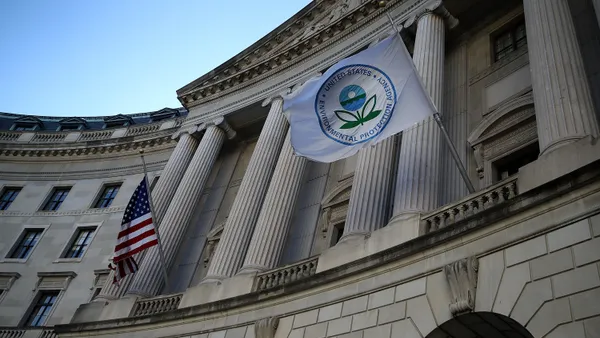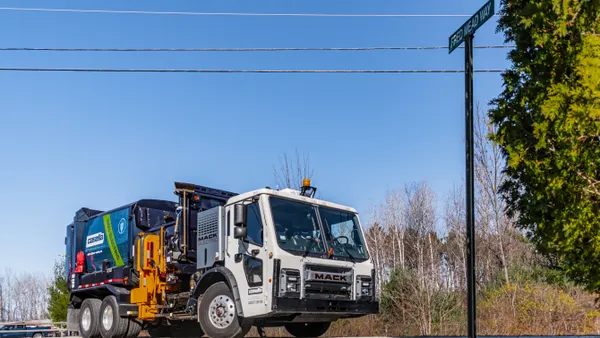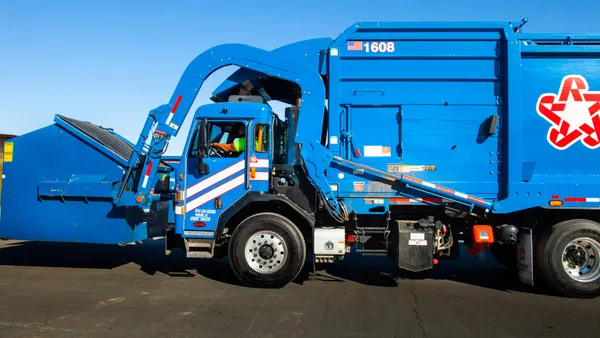UPDATE: Dec. 5, 2018: The San Francisco Board of Supervisors unanimously approved an ordinance that will require large generators to complete waste audits every three years. If generators are found to be out of compliance with existing city recycling requirements, they will have to hire "zero waste facilitators" for one year. The move is perceived as a way of adding teeth to the city's existing recycling requirements that, when passed nearly a decade ago, weren't written as tightly to ensure compliance.
Supervisor Ahsha Safaí, who introduced the proposal, said during the board meeting that the ordinance will bring greater equity to all city customers, since higher landfill costs are baked into the rates everyone pays. He also introduced a final set of amendments that will allow nonprofit generators, such as affordable housing complexes and food pantries, to apply for financial hardship exemptions.
Dive Brief:
- Following recent approval by the board's budget and finance committee, the San Francisco Board of Supervisors is set to consider a contested new recycling ordinance, as reported by The San Francisco Examiner. If approved, the ordinance would require select generators to hire "zero waste facilitators" by July 2020, and July 2021 for nonprofits.
- Any site that generates more than 40 cubic yards of waste per week — which currently comprises 419 large sites, including office buildings, hotels, restaurants, multi-unit housing and some city buildings — would be subject to audits every three years to ensure compliance with current recycling requirements. Those that fail the audit would be required to hire on-site facilitators at their own expense for one year.
- This proposal has attracted opposition — more over details than concept — from a range of building management associations, real estate interests and other business owners. The ordinance has been amended multiple times to limit the list of affected generators, reduce the frequency of audits, shorten the required employment period and extend the implementation timeline.
Dive Insight:
San Francisco set its lofty "zero waste" goal back in 2002, followed later by a mandatory recycling and organics separation ordinance in 2009. While the city has long been held up as the pinnacle of recycling success, local officials recently recognized that its goal of achieving "zero waste" by 2020 would not be possible. Over the summer, Mayor London Breed subsequently established a new goal of reducing waste generation by 15% and landfill disposal by 50% by 2030.
In looking at how to improve performance, the city has found that an estimated 60% of material going to landfills is recyclable or compostable. While progress can still be made in multiple sectors, the city reports that the large generators in question account for an estimated 20% of the city's landfill waste.
Recology maintains that the average building in question could indeed attain a 90% "recovery rate" or better with the right practices in place. Buildings already employing dedicated or part-time facilitators have reportedly seen improvements in their recycling rates and, in some cases, saved money on refuse service as well. One notable example cited during the committee process was AT&T Park, home of the San Francisco Giants.
But all of this can also present logistical and labor expenses upfront, which have spurred various critiques from generators and legislators alike. Certain members of the committee have also raised questions about the ordinance's approach and potential effects, leading to multiple hearings over a period of weeks.
The Building Owners and Managers Association has been among the most vocal skeptics, in part because it says property owners don't have the ability to police their tenants' habits. According to San Francisco's Department of Environment, an estimated five city sites on the list would likely fail their own audits at a cost of $416,000 to $832,000 per year. However, labor unions — including SEIU Local 87, which represents janitors — are supportive.
As demonstrated by San Francisco, regulating commercial and multi-unit residential buildings has proven complicated in many cities. Such generators also present some of the biggest potential for improvement. Questions about tenant accountability and general logistics in large sites are important to consider, but responsibility from all parties is unavoidable in cities aiming for such ambitious "zero waste" or high diversion rate goals.













